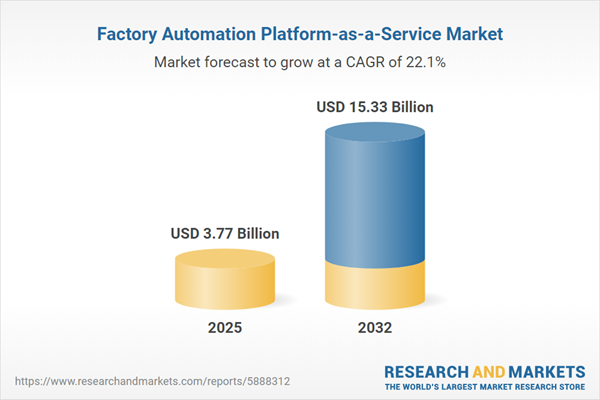Speak directly to the analyst to clarify any post sales queries you may have.
Factory automation platform-as-a-service (PaaS) is transforming manufacturing by integrating industrial IoT, real-time analytics, and cloud-native infrastructure into unified environments, empowering organizations to achieve higher levels of operational efficiency and streamlined production outcomes.
Market Snapshot: Factory Automation Platform-as-a-Service Market
The factory automation platform-as-a-service market grew from USD 3.09 billion in 2024 to USD 3.77 billion in 2025, and is projected to maintain robust expansion at a CAGR of 22.13%, reaching USD 15.33 billion by 2032.
Sustained digital transformation, the integration of machine analytics, and advancements in cloud-based delivery models are driving worldwide adoption. Factories are using PaaS solutions to modernize operations, ensure scalability, and align automation efforts with evolving industry requirements.Scope & Segmentation
- Component: Consulting Services, Data Analytics Tools (Descriptive, Predictive, Prescriptive Analytics), Integration Tools, Platform Software
- Deployment Model: Hybrid Cloud, Private Cloud, Public Cloud
- Organization Size: Large Enterprises, Small and Medium Enterprises
- End User Industry: Automotive, Chemicals and Petrochemicals, Electronics, Food and Beverage, Pharmaceuticals
- Application: Asset Tracking, Inventory Management, Performance Monitoring, Predictive Maintenance (Condition Monitoring, Failure Prediction), Quality Management
- Region: Americas (United States, Canada, Mexico, Brazil, Argentina, Chile, Colombia, Peru), Europe, Middle East & Africa (United Kingdom, Germany, France, Russia, Italy, Spain, Netherlands, Sweden, Poland, Switzerland, United Arab Emirates, Saudi Arabia, Qatar, Turkey, Israel, South Africa, Nigeria, Egypt, Kenya), Asia-Pacific (China, India, Japan, Australia, South Korea, Indonesia, Thailand, Malaysia, Singapore, Taiwan)
- Key Companies: Siemens Aktiengesellschaft, Schneider Electric SE, ABB Ltd, Rockwell Automation, Inc., Emerson Electric Co., Honeywell International Inc., Mitsubishi Electric Corporation, PTC Inc., Microsoft Corporation, Amazon Web Services, Inc.
Key Takeaways
- Factory automation PaaS enables real-time data ingestion, descriptive and predictive analytics, and prescriptive optimization for enhanced asset management and quality control.
- Hybrid deployment models allow organizations to achieve balance between security, operational agility, and cost-control, serving both large-scale and targeted enterprise needs.
- The rise of edge computing and industrial IoT is facilitating localized analytics, low-latency decision-making, and better orchestration of distributed production processes.
- Cybersecurity integration is a critical focus, with providers embedding protocols for device authentication, encrypted communications, and comprehensive vulnerability scanning.
- Emerging trends highlight growing investments in consulting services, advanced analytics tools, and modular integration frameworks to guide digital transformation and ensure business resilience.
Tariff Impact on Market Dynamics
The introduction of United States tariffs in 2025 has reshaped the procurement landscape for hardware and critical components, increasing landed costs and introducing uncertainty into project budgets. As a result, manufacturers are exploring domestic sourcing and supply chain reconfiguration, as well as pivoting toward software-centric strategies to mitigate cost volatility. Service providers increasingly offer cloud-based, subscription models to offset upfront expenses and manage risk, with risk management and supplier diversification rising in priority for businesses navigating these changes.
Methodology & Data Sources
This report applies a rigorous mixed-methodology approach, combining secondary research from industry literature, regulatory documents, and corporate white papers with primary interviews conducted among senior executives, technology vendors, and system integrators. Quantitative analysis includes segmentation by application, industry vertical, deployment model, and organizational scale. Findings were validated through triangulation and iterative expert consultations to ensure reliability and depth of insight.
Why This Report Matters
- Decision-makers gain actionable intelligence for strategic investments in factory automation PaaS, supporting efficiency improvements and holistic technology adoption.
- The report equips organizations with an understanding of segment trends, regional dynamics, and competitive positioning—essential for risk planning and transformation roadmaps.
- It identifies critical cybersecurity, sustainability, and skills development considerations that are central to successful platform deployments and long-term operational excellence.
Conclusion
Factory automation platform-as-a-service is advancing operational efficiencies and competitiveness across industries. As evolving technologies, regulations, and market dynamics converge, organizations adopting an adaptive and evidence-based approach will secure resilient and sustainable manufacturing outcomes.
Additional Product Information:
- Purchase of this report includes 1 year online access with quarterly updates.
- This report can be updated on request. Please contact our Customer Experience team using the Ask a Question widget on our website.
Table of Contents
3. Executive Summary
4. Market Overview
7. Cumulative Impact of Artificial Intelligence 2025
Companies Mentioned
The companies profiled in this Factory Automation Platform-as-a-Service market report include:- Siemens Aktiengesellschaft
- Schneider Electric SE
- ABB Ltd
- Rockwell Automation, Inc.
- Emerson Electric Co.
- Honeywell International Inc.
- Mitsubishi Electric Corporation
- PTC Inc.
- Microsoft Corporation
- Amazon Web Services, Inc.
Table Information
| Report Attribute | Details |
|---|---|
| No. of Pages | 185 |
| Published | October 2025 |
| Forecast Period | 2025 - 2032 |
| Estimated Market Value ( USD | $ 3.77 Billion |
| Forecasted Market Value ( USD | $ 15.33 Billion |
| Compound Annual Growth Rate | 22.1% |
| Regions Covered | Global |
| No. of Companies Mentioned | 11 |








